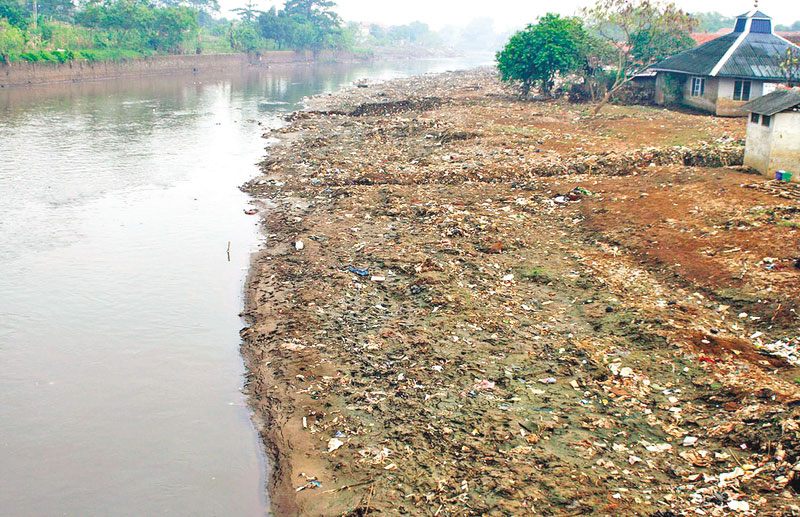Paracetamol and a range of other medicinal waste has been found in various locations along the Citarum River, West Java.
Specifically for paracetamol, the levels were twice as high as those found in Jakarta Bay in a different study.
Through a study carried out by a number of researchers from the University of York, UK, it is known that there are various active substances contaminating the Citarum River.
In addition to paracetamol, there is nicotine; carbamazepine, which is commonly used as an epilepsy drug; and metformin, which is often used as a diabetes drug. There is also waste of a number of antibiotic drugs.
Based on data from 10 sampling locations in the Citarum River, samples at two locations showed that paracetamol levels reached 1630 nG/L and 1590 nG/L.
This number is much higher than the findings of paracetamol in Jakarta Bay which were revealed by researchers from the National Research and Innovation Agency (BRIN) and the University of Brighton, UK, in 2021.
A preliminary study published in the journal Marine Pollution Bulletin last June 2021, found that paracetamol contamination in Muara Angke reached 610 ng/L, the highest concentration ever found in seawater.
If we look at the average concentration of medicinal waste that has accumulated based on a University of York study, the waste in the Citarum River is far below the severity of rivers in Lahore, Pakistan. The Citarum River reached 5460 ng/L, while the Ravi River in Lahore was the worst hit with 70,700 ng/L.
This figure, as presented in this study, reflects the fact that contamination of pharmaceutical waste in various rivers around the world poses a “threat to the environment and world health”.
Dr John Wilkinson said the Nam Khan River in Laos also contains medicinal waste. This study examined a sample of 1,052 sites in 104 countries. As a result, about 25 percent of the 258 rivers studied contained “active medicinal substances” at levels believed to be unsafe for aquatic organisms.
“Usually, what happens is that we consume this chemical. The substance produces the desired effect and then leaves our body. What we know now is that even the most modern and efficient wastewater treatment plants are not fully capable of breaking down these substances before being discharged into rivers or lakes,” explained Dr John Wilkinson, the lead researcher of the research team, as reported by BBC News.
The Blue River in Tunis is one of the rivers with the highest medicinal content, according to the study. The drugs most commonly found at the sampling sites were also carbamazepine and metformin. The other three substances most commonly found are caffeine, nicotine, and paracetamol.
In Africa, artemisinin, which is used as an antimalarial drug, is also found in high concentrations.
“We can say that [the impact of the presence of pharmaceutical waste in rivers] is likely to be negative. But individual tests have to be carried out and currently, such studies are relatively few,” Dr Veronica Edmonds-Brown, an aquatic ecologist at the University of Hertfordshire, told BBC News. “This condition will worsen before we increasingly use pharmacological solutions for every disease, whether it’s physical or mental.”
The report states that more and more antibiotics in rivers can lead to the development of antibiotic-resistant bacteria. This will undermine the effectiveness of the drug and ultimately pose a “threat to the environment and global health”.
The most polluted rivers are in low- to middle-income countries, such as Pakistan, Bolivia, and Ethiopia. Oftentimes, the rivers are used as waste disposal sites for pharmaceutical factories.
“We have seen polluted rivers in Nigeria and South Africa. These rivers have very high concentrations of medicinal waste and this basically goes back to inadequate wastewater treatment facilities,” said Dr Mohamed Abdallah, professor of pollution waste at the University of Birmingham, UK. “This is the most worrying because there are the most vulnerable populations and lack access to health facilities.”
The Nairobi River in Kenya is one of the most polluted rivers in terms of medicinal waste. When asked what could be done, the research team leader, Dr Wilkinson, was sceptical.
“There must be a lot of people who are smarter than me to deal with this problem. One of the few things that could have an impact right now is how to use drugs more appropriately,” he said.
This means that access to antibiotics must be made difficult and the dosing tightened.
The research report can be read in the journal the Proceedings of the National Academy of Sciences.




